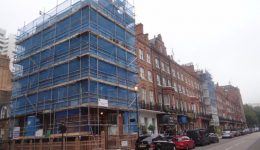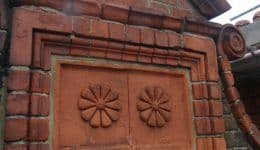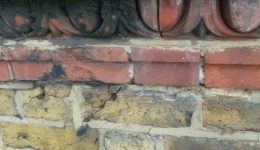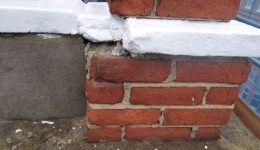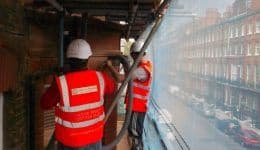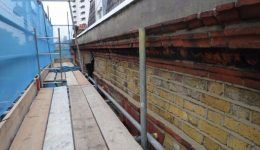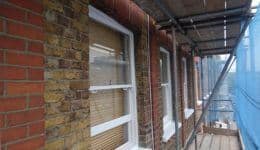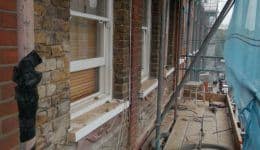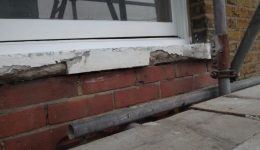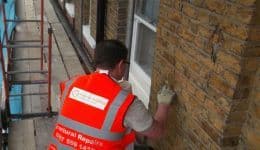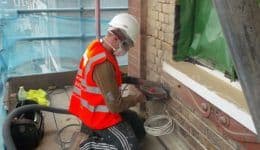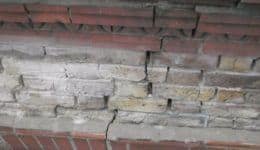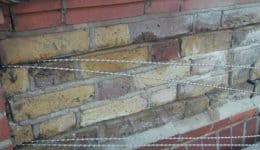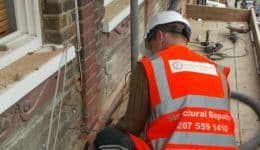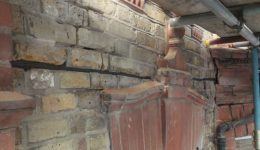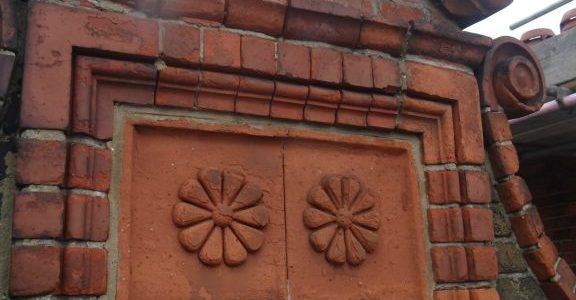
Structural Repairs Central London
Newman’s have recently restored the structural integrity and the aesthetically pleasing décor of this 5 storey Victorian built mansion house just off of Baker Street, Central London.
The property is believed to have been constructed in the early 1830’s and has stood the test of time although falling into a state of disrepair this property was of high value considering its location. The property was in the process of being converted into high specification flats.
We were called upon to provide an external survey as diagonal cracking was evident above window openings, cracked bricks and signs of bowing masonry. The bay window at the front of the property was originally a three storey bay window but the ground floor had been removed and RSJ’s installed to support the masonry above.
Our survey concluded that brick arch lintel failure was present along with a lack of lateral restraint causing a bow in the masonry at floor and ceiling levels. As well as these structural defects we discovered that the construction of the external masonry was believed to be of thirteen inch solid wall construction which is common given the height of the property, upon closer inspection we discovered that the wall construction was actually nine inch solid wall with a single skin external façade which was at no point tied into the internal skin.
We were asked by the main contractor’s structural engineer to provide a remedial solution that would restore the structural integrity causing as little disruption to the original façade retaining the aesthetics of the property.
Our solution was to create masonry beams using Twistfix helical rods embedded in grout above the window openings to distribute the loads, 450mm stainless steel ties vertically installed through the lintel pinning the lintel to the masonry above and the bed joints raked out and injected with Twistfix resin alleviating the need for disruptive and costly remove and rebuild techniques.
The bowing masonry was repaired using a combination of bed joint reinforcement and lateral restraint ties. Bed joint reinforcement is used to create beams in the masonry and drilled into the internal leaf of the masonry restraining the outward force. Lateral restraint ties are installed through the brickwork and into the timber floor joists and are then fixed using resin. This method of repair is similar to the large tie bars which are present on many period properties, but this method is far simpler and faster to install also causing less disruption internally.
Installing Lateral Restraint Ties
With the construction of the masonry providing major concern to ourselves and the structural engineers involved with the project it was essential we designed and implemented a repair solution that would restrain the external skin of masonry and prevent it acting as a free structure with the potential for collapse. Twistfix 9mm remedial wall ties were used at 450mm centres offering 4 ties per square metre. Pull out tests were carried out to 50% of the ties installed achieving well over the 2 KN’s of pull-out force required. The installation of the ties was very quick with only a 6mm pilot hole required and no setting times for resins or grouts with this dryfix method enabling the ties to become load bearing instantly.
As well as structural defects aesthetical repairs were required to the stone window cills and ornate decorative features. These were repaired using a range of concrete and stone repair mortars matching the existing profiles and once decorated looked like new.
Over 200 bricks were found to be suffering from freeze thaw cycle causing damage, spalling and discolouration to the face of the brick. Utilising specialist brick repair mortars the bricks were restored and tinted to match the existing masonry.
The restoration was carried out in less than two weeks fully restoring the external elevations structurally and aesthetically. If you have a similar project please contact us for any advice or specifications and we will be pleased to assist.
To find out more about this project or for general advice contact us today.
